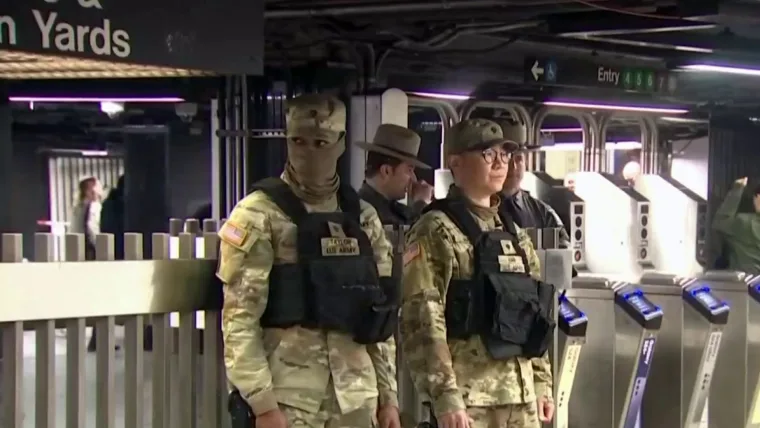National Guard New York Subway – The National Guard’s presence in the New York City subway system is part of a broader effort to enhance security and ensure public safety, particularly in response to heightened threat levels or specific incidents. Here’s a comprehensive overview:
Overview of National Guard New York Subway
Purpose and Role
- Security Enhancement: The National Guard is deployed to augment the security measures already in place by the New York City Police Department (NYPD) and the Metropolitan Transportation Authority (MTA).
- Visible Deterrent: Their presence acts as a visible deterrent against potential threats and provides reassurance to the public.
- Emergency Response: The National Guard can quickly respond to emergencies, including terrorist threats, natural disasters, and other critical incidents.
Historical Context
Post-9/11 Deployment
- Initial Deployment: Following the September 11, 2001 terrorist attacks, the National Guard was first deployed in the NYC subway system as part of the heightened security measures.
- Ongoing Presence: Since then, their presence has been periodically maintained during elevated threat levels and major events.
Recent Deployments
- Global Threats: The National Guard has been deployed in response to various global and domestic threats, including terrorism alerts and significant international events that may impact security in NYC.
- Local Incidents: They may also be deployed in response to local incidents, such as significant crimes, emergencies, or intelligence about potential threats.
Duties and Responsibilities
Patrol and Surveillance
- Station Patrols: New York National Guard Subway patrol subway stations, especially major hubs, to monitor activities and deter criminal behavior.
- Train Patrols: They occasionally ride subway trains to maintain a security presence across the transit system.
Coordination with NYPD and MTA
- Joint Operations: The National Guard works closely with the NYPD and MTA police in joint operations, sharing intelligence and coordinating responses.
- Support Roles: They assist in conducting bag checks, surveillance, and other security operations as needed.
Emergency Preparedness
- Quick Reaction: The National Guard is trained to respond swiftly to emergencies, including evacuations, medical emergencies, and security threats.
- Drills and Training: They regularly participate in drills and training exercises to remain prepared for various scenarios, ensuring a coordinated response with other agencies.
Impact on Public Perception
Reassurance
- Public Safety: The presence of the National Guard provides a sense of safety and reassurance to the millions of daily subway riders.
- Visibility: Their visibility in uniform acts as a psychological deterrent to potential criminals and those contemplating disruptive activities.
Concerns
- Public Reactions: While many riders feel safer, some may have concerns about the increased military presence in civilian spaces.
Coordination with Other Security Measures
Technology Integration
- Surveillance Systems: The National Guard’s deployment complements the extensive network of surveillance cameras and other technologies used by the MTA and NYPD.
- Communication Systems: Effective communication systems are in place to ensure real-time sharing of information and coordination during incidents.
The National Guard’s involvement in the New York City subway system plays a crucial role in maintaining security and public safety. Through coordinated efforts with the NYPD and MTA, their presence enhances the overall security framework of one of the world’s largest and busiest transit systems. Their periodic deployment in response to threats and major events underscores the importance of vigilance and preparedness in safeguarding the city’s vital transportation network.
Hochul National Guard NYC Subway
Governor Kathy Hochul’s deployment of the National Guard in the NYC subway system is a security measure to enhance public safety. This initiative involves National Guard in NYC Subway patrolling subway stations and working alongside the NYPD and MTA police to deter crime and respond to emergencies, particularly during periods of heightened threat or significant events.
Gov. Hochul deploys National Guard troops to NYC Subways
- Governor Hochul’s Decision: Governor Kathy Hochul deployed National Guard troops to the NYC subway system.
- Purpose: The deployment aims to enhance security and public safety in response to potential threats or incidents.
- National Guard Presence: Troops are stationed in subway stations to patrol and monitor activities.
- Collaboration: They work in coordination with the NYPD and MTA police to deter crime and respond effectively to emergencies.
- Visibility: Their presence serves as a visible deterrent and reassurance to subway riders and the public.
- Periodic Deployment: This measure may be implemented periodically in response to specific security concerns or events.
New York Governor National Guard Subways
- Role: The New York governor can deploy the National Guard to assist in various situations, including maintaining security and providing support during emergencies.
- National Guard: They are trained military personnel who can be mobilized by the governor to help with tasks such as patrolling subways, ensuring public safety, and offering aid during natural disasters or civil unrest.
- Subway Security: The National Guard may be deployed to enhance security measures in New York City’s subway system, particularly during times of heightened security threats or when additional personnel are needed to maintain order.
- Emergency Response: In times of crisis, such as terrorist attacks or major disruptions, the National Guard can provide essential assistance in coordinating evacuation efforts, providing medical aid, and ensuring the safety of commuters.
- Collaboration: The deployment of the National Guard in subways involves coordination between state and local authorities to ensure effective response and communication in emergency situations
![NYC Subway Map [New York Subway Map] ❤️](https://nycsubwaymap.net/wordpress/wp-content/uploads/2023/12/NYC-Subway-Logo.png)
